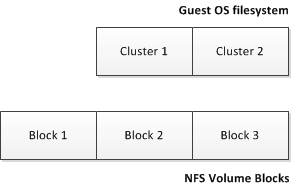Most of the modern operating systems automatically align partitions when they are installed in virtual machines. For example, Windows Server 2008 creates a default partition offset of 1024 KB to satisfy the partition alignment requirements. The following figure shows an example of correct partition alignment:

In this example, any cluster (the smallest unit of data) in the guest OS file system is aligned with the boundaries of an NFS block, and reading from or writing to a cluster requires only access to one NFS block. For example, reading from Cluster 1 causes only a read from Block 1.
At the same time, virtual machines running non-modern systems (for example, Windows Server 2008 or Red Hat Enterprise Linux 5) do usually have misaligned partitions, which is shown in the figure below:

In this example, clusters of the guest OS file system do not match the boundaries of NFS blocks, and reading from or writing to a cluster requires access to several NFS blocks. For example, reading from Cluster 1 causes two reads: from Block 1 and from Block 2. This results in a slower read time as compared to properly aligned partitions and leads to performance degradation.

